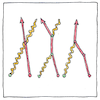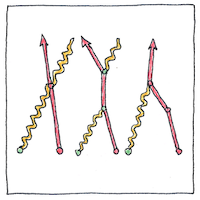Hans Bethe, Julian Schwinger, Shin'ichirō Tomonaga, Freeman Dyson, Richard Feynman
quantum mechanics

|
Quantum electrodynamics
Electrically charged particles move, interact, emit and absorb photons, create force fields, act like waves, act like particles, within certain probabilities consistent with special relativity. Now these behaviors can be described, formulated, renormalized, quantified with extreme precision, and illustrated with Feynman diagrams.
Superpositions
Every alternative happens at once, every state superimposed in time, so to calculate the probability of an electron moving from here to there, one would need to consider all paths including intermediate events, which is impractical; however, virtual particles in closed loops return particles to their real states, so we can cut the Gordian knot. Increasingly complicated calculations eventually increasingly diminish in importance.
Virtual
Does any virtual particle escape to become actual? Hopes come true; dreams awaken; silliness persists. Many agree God has a sense of humor, like a zen potter who deliberately adds a flaw. Fun to tease these things out.



A Feynman diagram does not show how a particle moves from one point to another; the particle’s path, speed, dimensionality, and nature are still mysteries, although quantum electrodynamic theory describes the probabilities that it undergoes events, such as when an electron absorbs or emits a photon, or when a quark-antiquark pair radiates a gluon. Quantum electrodynamics is a part of quantum field theory; a field is a function that assigns a value for each point in a space (of some kind).
See also in The book of science:
Readings in wikipedia: